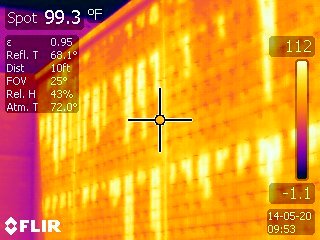thoughtofthis
Structural
We've noticed that our partially grouted walls end up containing more grout than we would like. It looks like the stretcher block may be part of the issue.
Issue #1: ACI 530.1 3.3B 3d says, "Vertical cells to be grouted are aligned and unobstructed openings for grout are provided in accordance with the Project Drawings." Webs of stretcher blocks cannot line up.
Issue #2: Masonry Design Guide, NCMA Inspectors Handbook, etc. state, "Where only selected cells are to be grouted, the cross webs adjacent to those cells should be mortared to confine the grout to those selected cells." If the webs don't line up, this isn't possible.
With stretcher blocks in a running bond, you're theoretically left with a 3 in. wide vertical opening for the reinforcing (which is acceptable); however, you're also left with a 1 1/8 in. gap that leads to adjacent cells. If you pump 8 in. - 11 in. slump grout, it's nearly impossible confine grout to only the reinforced cells without additional steps. To confine the grout, you would have to cover every stretcher end with wire mesh in every course? That seems more labor intensive than just laying a standard square end block. Also, how do you make sure the mesh was placed? I doubt an inspector could verify 100% at the bottom of a 48 in. lift.

Is the solution to specify standard blocks for partially grouted walls? What are the benefits of using stretcher blocks anyway?
Issue #1: ACI 530.1 3.3B 3d says, "Vertical cells to be grouted are aligned and unobstructed openings for grout are provided in accordance with the Project Drawings." Webs of stretcher blocks cannot line up.
Issue #2: Masonry Design Guide, NCMA Inspectors Handbook, etc. state, "Where only selected cells are to be grouted, the cross webs adjacent to those cells should be mortared to confine the grout to those selected cells." If the webs don't line up, this isn't possible.
With stretcher blocks in a running bond, you're theoretically left with a 3 in. wide vertical opening for the reinforcing (which is acceptable); however, you're also left with a 1 1/8 in. gap that leads to adjacent cells. If you pump 8 in. - 11 in. slump grout, it's nearly impossible confine grout to only the reinforced cells without additional steps. To confine the grout, you would have to cover every stretcher end with wire mesh in every course? That seems more labor intensive than just laying a standard square end block. Also, how do you make sure the mesh was placed? I doubt an inspector could verify 100% at the bottom of a 48 in. lift.

Is the solution to specify standard blocks for partially grouted walls? What are the benefits of using stretcher blocks anyway?

![[smile] [smile] [smile]](/data/assets/smilies/smile.gif) If I only need vertical bars at 32 in. o.c., I shouldn't get a fully grouted wall.
If I only need vertical bars at 32 in. o.c., I shouldn't get a fully grouted wall.